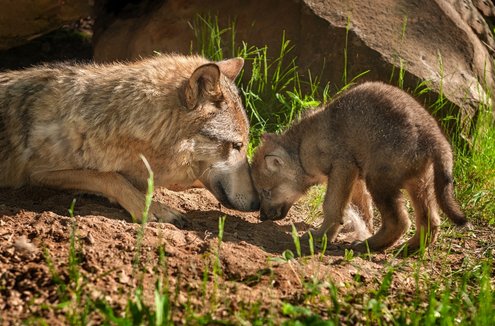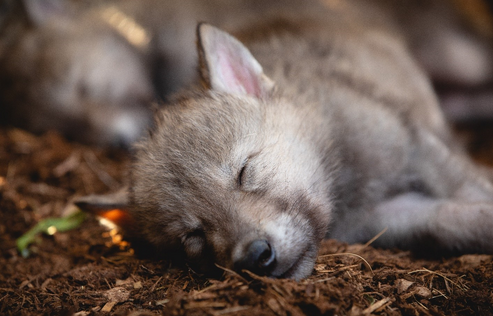Springtime is the time of new life and family unity for wolves. The whole year before and after revolves around preparing for pups and caring for them until they reach 10 months of age and can take care of themselves. The pups are so cherished by the adults that they can do no wrong: chewing on noses, tails, and mock stalking are all part of being a wolf parent and they suffer these little annoyances often with a grin and encouragement to their little challengers. Play is a way to bond with the family as well as learn the skills needed to be a good hunter. And wolves are among the most important hunters in our ecosystem. They have a unique gift in smelling disease, decay and distress in their prey and focusing on those animals, which helps preserve the health of elk and deer herds and keeps these herds smaller and moving. This is important because herds that become too stationary or too large destroy their own habitat by stripping new growth that feeds other species and protects the soil from erosion. Nature’s perfect system that has evolved over hundreds of thousands of years. This was the primary goal in restoring wolves to Yellowstone, the Northern Rockies, and the West. The reintroduction of wolves to Yellowstone and Idaho was one of the most successful wildlife recovery efforts in our nation’s history. That all changed this Spring.
This Spring, only a decade after wolves lost their federal protection under an agreement with the states of Idaho and Montana to manage wolf populations the way they manage other valued wildlife, the Republican governors signed legislation that harkens back to the brutal persecution of wolves that ultimately led to their full eradication from the Western United States. It wasn’t enough that hunters were killing over one third of the wolves and that government agents were gunning down entire packs each year. Now, they are paying bounties for dead wolves across the region, including newborn pups and their mothers, allowing thousands of snares on our national public lands that slowly choke wolves and other unfortunate animals including our pet dogs to death, and giving wolf haters permission to kill as many wolves as they can.
People who care about the treatment of wildlife are often shocked to learn of this brutality. Many think that wolves are being hunted in a similar way to bears, mountain lion, and deer. They’re wrong. We don’t allow anyone to legally kill bears or mountain lions this way or any other valued species. And while Idaho still maintains the terrible Spring bear hunt where “hunters” can set packs of dogs trained to kill on mother bears and their defenseless cubs, they do even worse to wolves.
This Spring, a mother wolf gave birth to eight pups. This was her first litter. She had picked a beautiful place to dig her den with tall trees, open green meadows, and a nearby stream nestled in the valley surrounded by tall mountains and rolling green foothills. She and her mate were unaware that they had a name – the “Timberline Pack” – given to the wolves of this area by Timberline high school students in Boise, whose school mascot is the wolf. Their motto “The strength of the wolf is the pack and the strength of the pack is the wolf” is painted above the doors in their hallways.
For several weeks, this new family lived in peace with the mother wolf giving warmth and nourishment to her tiny pups that were born blind and deaf but still so full of instinct that they whimpered and softly howled to each other even before their eyes opened. Their father brought her food and devotedly stood guard of the den to protect her and their new pups from bears and strange wolves. She would slip out every few days for water while he stayed to protect their litter. In just a few weeks, the pups opened their eyes to their new world. By now, they recognized their mother and each other by scent, their strongest sense. Crawling to the den opening, they met the sun, moon, and their father as they peered out into their new world. Encouraged by their mother, they followed each other to take their first steps outside the earthen den onto the grassy meadow floor.

It was the radio collar around their father’s neck that gave away their location. Their parents had taken all precautions to keep them safe but could not anticipate that a paid killer with a rifle was waiting downwind and on May 18th, half of their pups would be shot and killed at their den site. The surviving pups scrambled back into the den with their mother as the paid killer picked up the bodies of their siblings and stuffed them into a bag. Their father ran away in fear and confusion but stopped not far from the den to bark in anguish against their unknown intruder. The paid killer had instructions. Leave the father alive so they could track him back to his mate and their young pups.
When the parents were sure that the intruder was gone, they did what other parents would do when protecting their young. They moved them to a new location. It wasn’t as safe as the den had been, but they couldn’t detect the smell of the paid killer or his kind there. The pups were now exposed to rain and other predators, but they were safer on the run than at the den. They lived this way for nearly a month. Moving from hidden glades and deep woods, the parents diligently raised their pups that could now eat meat that a parent regurgitated (think baby food) for them. They spent their days sleeping during the hottest part of the day and moving at night under the cover of darkness. Then, on June 10th, a shot rang out and one of the pups fell dead. In a panic, the others ran with their parents as fast as they could. Only three pups remained. For five more days and nights, the parents kept them on the move desperately trying to save their young. On the sixth day, the stalker caught up with them again and killed the last three as they tried to run away from this relentless danger.

Crying Wolf
All of this occurred because a single rancher demanded it. And the American people paid for it through funding to USDA APHIS Wildlife Services (WS) whose mission is supposed to be “to provide Federal leadership and expertise to resolve wildlife conflicts to allow people and wildlife to coexist.” WS claims that they killed the pups “pre-emptively” before any livestock were harmed this year because there were “chronic” losses to wolves in this area in the past. Kind of like shooting someone because they were in the neighborhood where a car was stolen six months ago. And they define “chronic” as one or more losses in an area. Can you think of anything that is defined as chronic when it happens only once? In the last six months, WS has confirmed that wolves have killed 54 livestock in Idaho. A total of 54 cattle and sheep out of 2.5 million cattle and 300,000 sheep statewide. Thousands of livestock are lost to disease, bad weather, stress, and neglect. The loss of 54 is not even remotely a crisis. And WS notes that this is the highest loss of livestock since wolf reintroduction in 1995.
Regarding elk and deer issues, the situation in quite similar. A lot of bellyaching and blame being tossed at wolves when the overall elk population has increased in number over the last 25 years since the wolves were reintroduced. Idaho Fish and Game managers are calling this the “the second Golden Age of Idaho elk hunting.”
Fair Chase?
The states of Idaho and Montana are also now in open violation of longstanding wildlife management practices and sportsmen ethics by permitting the hunting, trapping, and snaring of an unlimited number of wolves on a single tag. They are openly seeking to kill up to 90% of their wolves, which still number far fewer than bear or mountain lion populations. Hunters can now legally chase down wolves on snowmobiles and ATVs. They can hunt and trap during the birthing and pup-rearing season killing newborn pups and nursing mothers. Sportsmen and wildlife managers in the West and around the world have long-opposed unethical practices like these, since they violate “fair-chase” principles giving hunters an improper advantage over wildlife. This Spring, another litter of pups was reportedly killed by a man who crushed the wolf pups to death and then turned their bodies in for the bounty of up to $1,000 each. They were only days old and had never even opened their eyes. He was unable to claim bounties for all eight because he only had a permit for killing six of them when he raided the den. Another man bragged during an Idaho Fish and Game Commission hearing that he has set hundreds of snares. These wire devices choke their victims to death sometimes over a period of days before the animal is completely strangled to death. If this is what passes for hunting now in Idaho and Montana, we seriously need to reconsider allowing these “hunters” on our public lands.
The Alternatives
If Idaho and Montana were as determined to proactively protect livestock as legislators appear to be toward just killing wolves, we could work together to resolve even hot spot areas and minimize livestock losses even more. Progressive, wildlife friendly ranchers are proving that beyond doubt in the Big Wood drainage area in Blaine County where the Wood River Wolf Project for 14 years has consistently held livestock losses to an average of only five sheep out of 20,000 annually grazing our nearly 500 square miles demonstration project area. Our losses are 3.5 times lower than producers in other areas where they rely on lethal control while we’re spending far less money to accomplish this without killing wolves. Yet, in Idaho, state law prohibits any of the wolf control taxpayer funds to be spent on effective deterrents rather than lethal control.
This is clearly about persecuting wolves rather than addressing the problems they’re blamed for. What this says about the people making these decisions is deeply disturbing. They either are fully aware that their goal is driving wolves back to eradication or they haven’t been concerned enough to look at the facts before blindly following those who are hellbent on persecuting wolves.
What can you do?
Wolves need all of us to take action. Donate. Make a call. Write a letter. Give 10 minutes or more of your time now and be the voice of those who cannot speak for themselves.
Their fate will change when enough people demand their protection. US Secretary of the Interior Deb Haaland can stop this persecution today. US Secretary of Agriculture Tom Vilsack can stop this persecution today. President Joe Biden can listen to his grandkids and direct his secretaries to stop the persecution of wolves today.

As in the words of L David Mech “If the wolf is to survive, the wolf haters must be outnumbered. They must be outshouted, out financed, and out voted. Their narrow and biased attitude must be outweighed by an attitude based on an understanding of natural processes.”
Join us today. We are determined to work until we succeed. Don’t let their ignorance or apathy stop you. Our wolves deserve nothing less than our best effort to save them.
- If you haven’t yet, please join our members who are making a monthly donation to help us promote coexistence around the world.
- Join our wolf activist community on Facebook. This is a private group that is committed to the conservation of wolves.
- Share this petition with others.
- Write to President Biden and Secretary Haaland directly and ask them to provide federal protections for wolves in the Northern Rockies.

Suzanne Asha Stone is the executive director of the International Wildlife Coexistence Network and Co-founder of the Wood River Wolf Project in Idaho. She was also part of the USA/Canadian wolf reintroduction team that restored wolves to Yellowstone and central Idaho. You can learn more about her work at www.wildlifecoexistence.org

